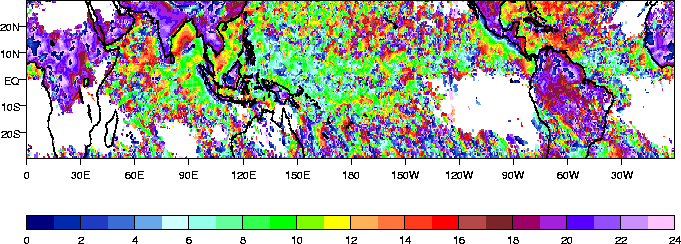
The development of a high resolution climatology of the diurnal cycle in convection, cloudiness and surface temperature has revealed several interesting facets, including the extent to which the strong diurnal signal over land is spread out over the adjacent oceans, probably through gravity waves of varying depths.
An archive of high resolution (3 hourly, 0.5 latitude/longitude grid) global window brightness temperature data from multiple satellites has been used to construct a climatology of the diurnal cycle in convection, cloudiness and surface temperature for all regions of the tropics. The results have demonstrated the universality of the characteristics of the diurnal cycle for land vs. ocean, clear sky vs. convective regimes. The maximum diurnal amplitude occurs over land clear sky regions, as a result of the large response of the surface temperature to daytime solar heating. For convective regimes, the diurnal amplitude is larger over continents than over oceans, and the phase of the diurnal harmonic is more spatially consistent. Oceanic deep convection tends to reach its maximum in the early morning. Continental convection generally peaks in the evening, although there are interesting regional variations, indicative of the effects of complex land-sea and mountain-valley breezes, as well as the life cycle of mesoscale convective systems (Figure 1(a)).


A striking result has been the extent to which the strong diurnal signal over land is spread out over the adjacent oceans, probably through gravity waves of varying depths. These coherent signals can be seen for several hundred kilometres and in some instances, such as over the Bay of Bengal, can lead to substantial diurnal variations in convection and precipitation. Over the complex system of islands which make up the Maritime Continent, these coherent signals in the diurnal cycle represent important land-sea breeze effects which may play a crucial role in the region's heat and moisture budget.
A complementary analysis of the diurnal cycle in the Met. Office Unified Model has demonstrated that the model has considerable difficulty in capturing the observed phase of the diurnal cycle in convection (Figure 1(b)), which suggests some fundamental difficulties in the model's physical parametrizations. Analysis of the diurnal cycle represents a powerful tool for identifying and correcting model deficiencies.